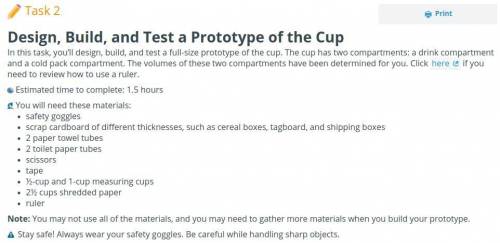Unit 2:Course Activity: Building a Device that Uses Energy from Chemical Reactions
Task 2
Par...

Physics, 10.12.2020 21:20 YARETZYVENCES2144
Unit 2:Course Activity: Building a Device that Uses Energy from Chemical Reactions
Task 2
Part A
What will the cup you’re building be used for?
Part B
Criteria are the goals that a design must achieve. They are determined by what you want the cup to do. Criteria for the volume of the cup compartments have been decided for you. The volume is expressed in four different units:
Volume
cubic centimeters milliliters fluid ounces cups
cold pack 150 150 5 0.6
drink compartment 600 600 20 2.5
total 750 750 25 3.1
Although the volume is set, the shape of the cup is up to you. There are no right or wrong answers. Do you want your cup to be tall and skinny or short and wide? Should it have a handle? List at least two other criteria for the shape of the cup and the location of its two compartments based on the question, What do you want it to do?
Part C
Constraints are the limits that we place on a design. Time, materials, or money might be in short supply. Some designs may also be limited by how the product gets used. List at least one constraint on the drinking cup design.
Part D
Question
Brainstorm ideas about the shape and construction of the cup. At this stage, you don’t need to calculate exact dimensions; instead, just think about the overall shape and placement of the cold drink compartment. Draw your ideas, and use text boxes to explain the ideas.
Part E
Question
Draw two fully worked-out ideas for the cup. Include exact dimensions and the placement of the cold pack compartment. Use text boxes to explain the ideas, and show the measurements. The total volume of the cup must be 750 cubic centimeters. The drink compartment must be 600 cubic centimeters to hold a 20-ounce drink. The cold pack compartment must be 150 cubic centimeters (the volume of the reactants in the chemical reaction from task 1). You may want to review how to calculate the volume of a cylinder or rectangular prism.
Part F
What are the pros and cons of each idea you explored in part E? How do the ideas compare?
Part G
Select one of the ideas from part E, and use items from the materials list to build a prototype of the cup. The prototype must show the shape of the cup, the handle, and the shape and placement of the cold pack compartment. The prototype cup must be true to size. (You don’t have to build the lids.) Describe what you did.
Part H
Test your prototype two ways. First, pick the cup up by the handle to see how it feels. Second, test whether the drink compartment holds 20 ounces (1 cup = 8 fl. oz.). Add 2½ cups of shredded paper to verify that your calculations are correct. Did the prototype have the right volume? Record the results of your tests here.
Part I
Question
Based on your tests in part H, change the cup design and rebuild the prototype, if needed. Draw the new design, and use text boxes to note any changes that you made.


Answers: 1


Another question on Physics

Physics, 21.06.2019 16:00
The rigid beam is supported by the three suspender bars. bars ab and ef are made of aluminum and bar cd is made of steel. if each bar has a cross-sectional area of 450 mm2, determine the maximum value of p if the allowable stress is (σallow)st = 200 mpa for the steel and ( σallow)al = 150 mpa for the aluminum. est = 200 gpa and eal = 70 gpa.
Answers: 2

Physics, 21.06.2019 21:00
50 g of ice at 0°c is dropped in a beaker containing 100 g of water at 0°c. what will be the contents of the beaker after 5 hours? assume that the room temperature is 0°c.
Answers: 1

Physics, 21.06.2019 22:30
Heena wants to measure the volume of a ball that is 24 cm across. how should she set up her equation?
Answers: 1

Physics, 22.06.2019 05:00
Which car has the most kinetic energy? a. a car of mass 1000 kg with a speed of 3 m/s b. a car of mass 2000 kg with speed 7 m/s c. a car of mass 1000 kg with speed 7 m/s d. a car of mass 2000 kg with speed 3 m/s
Answers: 1
You know the right answer?
Questions






Mathematics, 18.10.2021 18:20

Arts, 18.10.2021 18:20




Mathematics, 18.10.2021 18:20



Mathematics, 18.10.2021 18:20



English, 18.10.2021 18:20





